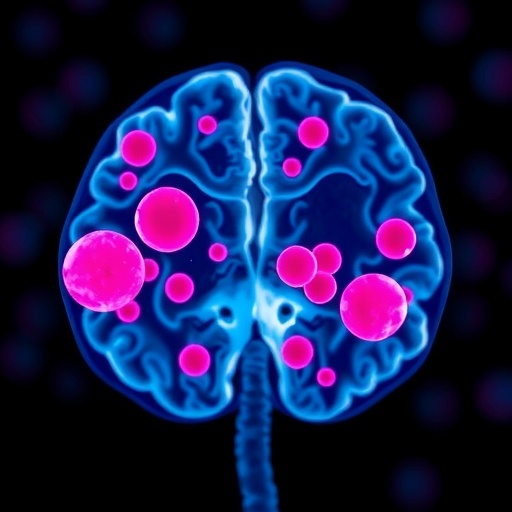In a groundbreaking study published in BMC Neuroscience, researchers have unveiled the complex role of eosinophils in the outcomes of patients experiencing strokes treated with mechanical thrombectomy. The study led by Yu et al. offers new insights into how these immune cells contribute to both early and delayed neurological deterioration, a critical aspect of stroke recovery that has puzzled scientists and clinicians for years. This revelation could pave the way for tailored therapeutic interventions that enhance recovery in stroke patients.
Eosinophils, often associated with allergic reactions and asthma, have been relegated to a lesser role in the context of ischemic strokes. However, this new research indicates that these cells may play a dual role in inflammation, either promoting tissue damage or facilitating repair, depending on the timing of their activity. This nuanced understanding suggests that eosinophils may be an important factor in the inflammatory response observed after mechanical thrombectomy.
In the research, the authors utilized a robust animal model to track the activity of eosinophils in the aftermath of a stroke. By performing mechanical thrombectomies in these subjects, the researchers were able to observe the cellular response and physiological changes in real-time. This meticulous approach underscored how eosinophils respond differently during the acute phase immediately following the procedure compared to their role during the delayed phase of recovery.
The acute inflammatory response is a double-edged sword; while it is essential for combating ischemic tissue injury, it can also exacerbate damage if not properly regulated. Eosinophils, with their ability to release a range of inflammatory mediators, come into play at this critical juncture. The study found that in the early phase post-thrombectomy, increased levels of eosinophils correlated with worsened neurological outcomes. This indicates that the early influx of these cells might contribute to exacerbated inflammation rather than healing.
In contrast, eosinophils showed a protective role in the delayed phase of recovery. The research highlighted that as the inflammation transitioned from a harmful response to one promoting recovery, eosinophils aided in tissue repair and regeneration. This fascinating dichotomy reveals the intricate balance required in the immune response during stroke recovery and raises important questions about how to modulate these immune processes for better patient outcomes.
The authors also examined the cytokine profiles associated with eosinophils during both phases. The differential expression of cytokines was associated with the timing of eosinophil action, lending weight to the argument that manipulating eosinophil activity could be a viable therapeutic target. In particular, strategies aimed at either inhibiting eosinophil activation in the early phase or enhancing their function during the recovery phase might hold promise for improving neurological outcomes in stroke patients.
Another crucial aspect of the study was its implication for future clinical practices. Understanding that eosinophils can have both detrimental and beneficial effects depending on their timing opens new avenues for intervention. This knowledge could lead to novel treatment protocols that take eosinophil dynamics into account, transforming how strokes are managed post-thrombectomy.
In addition to its clinical implications, this research also contributes to the broader understanding of immune system involvement in neurological diseases. The concept that immune cells traditionally viewed through a narrow lens could play multiple roles depending on their context urges a reevaluation of many existing paradigms within neuroinflammation and recovery. It underscores the need for ongoing investigation into how these processes are interlinked, as stress and recovery mechanisms could be more interconnected than previously thought.
As researchers continue to explore this complex interplay, the potential for eosinophil-targeted therapies becomes more tangible. Strategies may not only involve pharmacological interventions but also lifestyle adjustments and rehabilitation practices that align with the identified roles of these cells in stroke recovery.
This innovative study opens a vital dialogue about the importance of immune cell function in neurological outcomes and reinforces the need for interdisciplinary approaches to treatment strategies. As findings emerge, they hold the potential to revolutionize patient care paradigms with informed, precise approaches grounded on immune system responses.
The implications of this research extend beyond stroke treatment, potentially offering insights into other neurological conditions characterized by similar inflammatory profiles. A deeper understanding of eosinophils could lead to breakthroughs in managing various neurological disorders where inflammation plays a critical role, highlighting the versatile and often paradoxical nature of the immune response.
In conclusion, the work of Yu and colleagues not only sheds light on the specific mechanisms at play in stroke recovery but also sets the stage for comprehensive future investigations. By emphasizing the importance of timing in the immune response, this research paves the way for innovative therapeutic strategies that could significantly improve the quality of care for patients grappling with the aftermath of strokes.
At a time when neurological disorders represent a growing global burden, the insights gleaned from this research could be pivotal. As we enhance our understanding of eosinophils’ roles in neurological recovery, we may ultimately achieve better patient outcomes through targeted therapeutic developments.
Subject of Research: Eosinophils’ role in stroke recovery post-mechanical thrombectomy.
Article Title: Eosinophils differentially affect early and delayed neurological deterioration after mechanical thrombectomy in stroke.
Article References:
Yu, S., Yang, J., Han, X. et al. Eosinophils differentially affect early and delayed neurological deterioration after mechanical thrombectomy in stroke. BMC Neurosci 26, 34 (2025). https://doi.org/10.1186/s12868-025-00954-8
Image Credits: AI Generated
DOI: https://doi.org/10.1186/s12868-025-00954-8
Keywords: Eosinophils, stroke, mechanical thrombectomy, neurological recovery, inflammation, cytokines, immune response.




